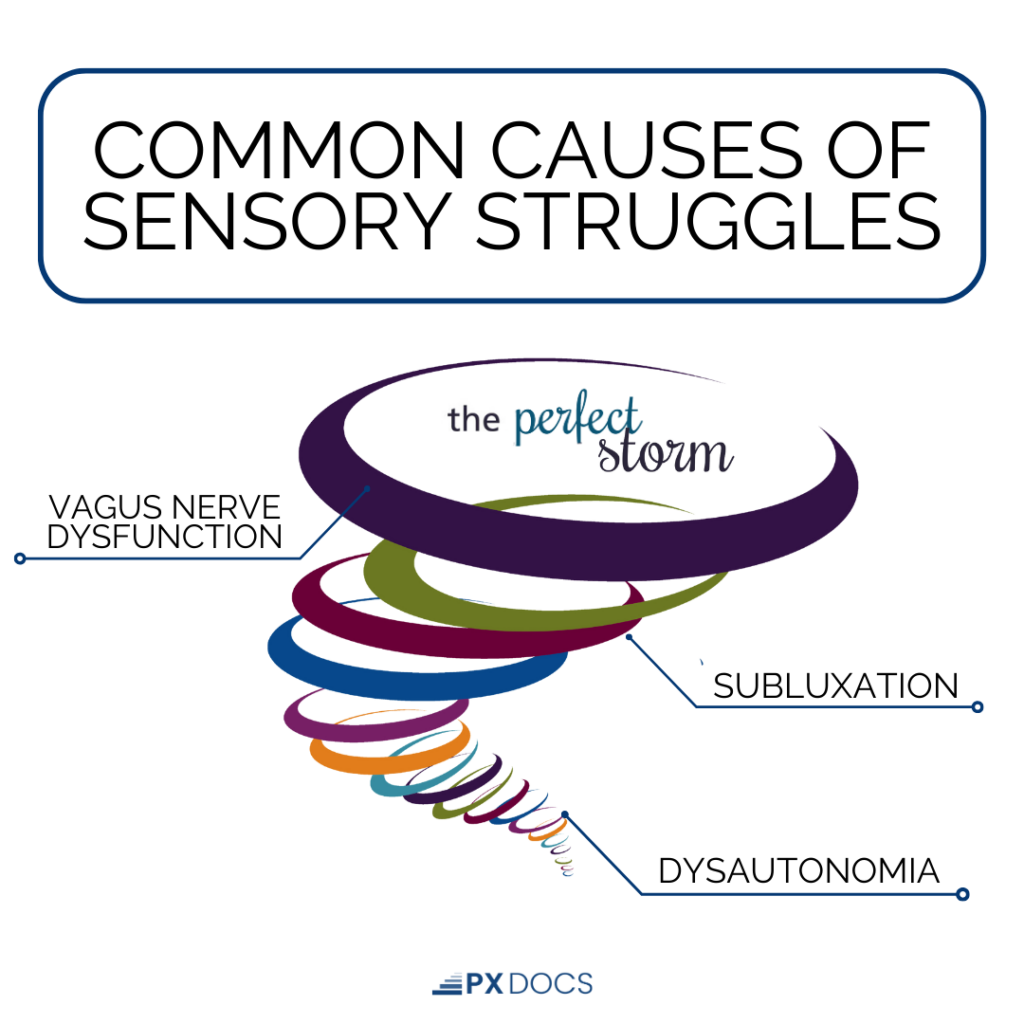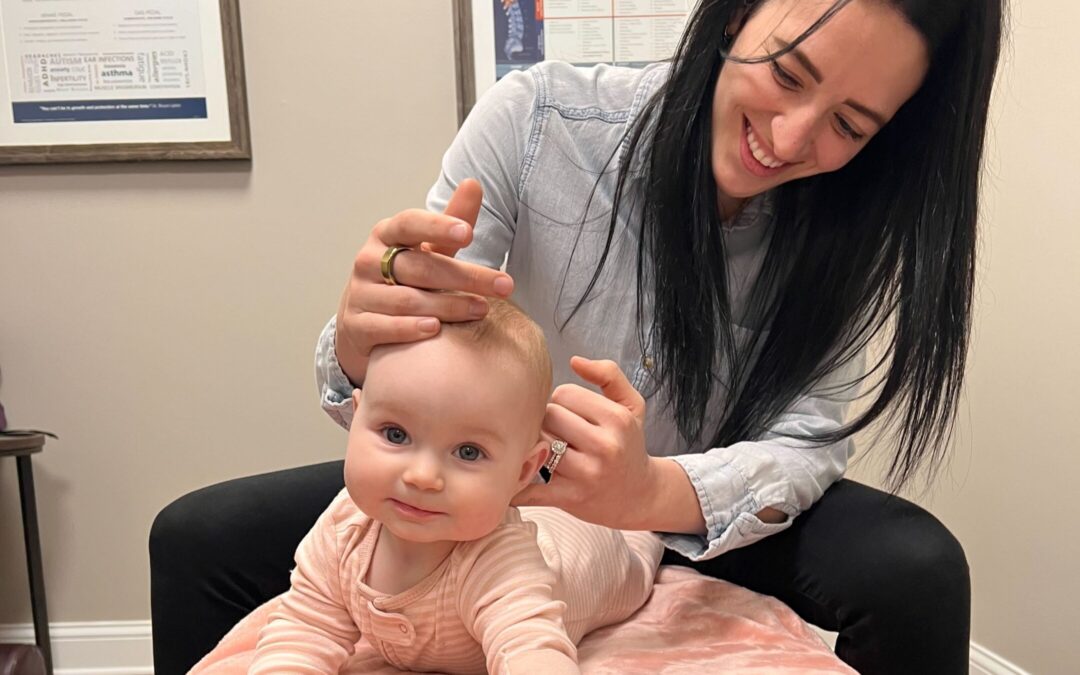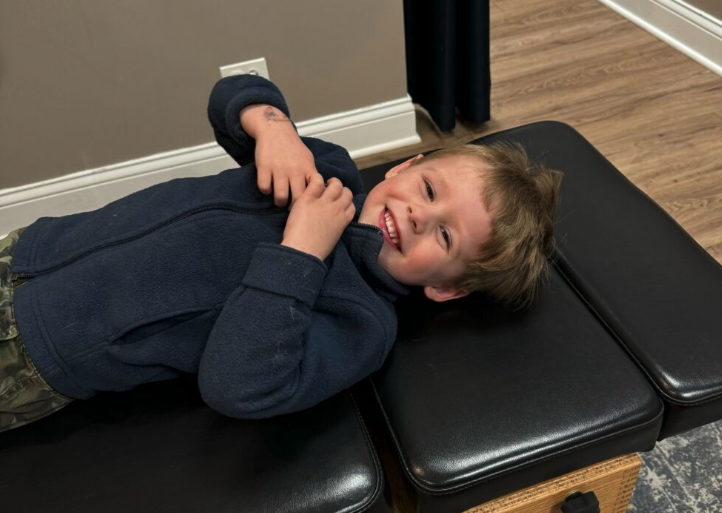Sensory processing is a fundamental aspect of our interaction with the world around us. For most kids, heading out into the world to play in nature, meet new friends, and try new things are experiences that bring joy and connection. But for some children, these seemingly sensory interactions and experiences can be overwhelming or even distressing.
That was certainly the case for Tierney before her family found Neurologically-Focused Pediatric Chiropractic. For so many years, she was limited to wearing only loose-fitting dresses and clothing because the seams and fabrics on most clothes caused her sensory system to go into overdrive and stressed her out to the max.
Thankfully, over time, using the natural + drug-free solutions covered in this article, Tierney was able to fully overcome her sensory issues and now lives a full, thriving, choose-any-outfit-she-wants life!
This article delves into the intricacies of sensory issues in kids – what they are, how they manifest, their impact, and strategies to help sensory kids and families thrive.
Defining Sensory Issues
Sensory issues, also known as sensory processing difficulties, encompass a range of challenges that involve how the nervous system receives, processes, and responds to sensory stimuli. These stimuli include sights, sounds, textures, tastes, and smells.
Sensory processing issues also create challenges for a child as they try to move through their environment and maintain their balance, known as proprioceptive and vestibular functions.
When working properly, the sensory nervous system does an incredible job of receiving sensory information from both the external and internal environment, integrating it into the brain, and coordinating the proper decisions and actions to take in response. Sensory processing and integration are essential elements of overall neurological functioning and development.
However children with sensory issues might demonstrate hypersensitivity (over-sensitivity) or hyposensitivity (under-sensitivity) to these various stimuli in their environment, which can have significant implications for their daily lives.
These issues are often associated with conditions like Sensory Processing Disorder (SPD) or Autism Spectrum Disorders. Sensory issues can affect various aspects of a child’s life, from their behavior and emotions to their social interactions and learning experiences. Identifying and addressing these challenges early on is crucial for providing the necessary care and support.
Prevalence and Impact on Child Development
Sensory issues are more common than we might think. Research indicates that they can be present in children both with and without diagnosed developmental conditions. The prevalence of SPD alone is estimated to be around 5-16% in children, with many studies showing it now as much as 1 in 6 kids born today. These challenges can significantly impact a child’s development and quality of life, making it imperative to foster awareness and understanding on a larger scale and then make appropriate care options available to more families.
The average pediatrician and medical provider still today not only will often completely overlook and miss sensory issues in your child but will often even dismiss them as “completely normal” and say something to the effect of “don’t worry, they’ll grow out of it” which is simply not the case.
Common Types of Sensory Issues in Kids
Over-Sensitivity (Hypersensitivity)
Children with hypersensitivity can find everyday sensations overwhelming. Here are some common types of sensory hypersensitivity:
Auditory Sensitivity: Even mild sounds might feel painfully loud to these children. Noisy environments, such as crowded classrooms or busy streets, can be distressing.
Visual Sensitivity: Bright lights, flickering screens, or intricate patterns might cause discomfort or even pain for children with visual sensitivity.
Tactile Sensitivity: Some children might be highly sensitive to touch, finding certain fabrics, tags on clothes, or even a gentle pat on the back uncomfortable or unbearable.
Olfactory Sensitivity: Strong smells that most of us barely notice can be intense and bothersome for children with olfactory sensitivity.
Gustatory Sensitivity: Certain tastes and textures of food might trigger strong reactions, making mealtime a challenge for children with gustatory sensitivity.
Under-Sensitivity (Hyposensitivity)
On the other end of the spectrum, some children have hyposensitivity, meaning they have a reduced response to sensory stimuli. This can lead to sensory seeking behaviors.
Proprioceptive Sensitivity: Children might seek out deep pressure activities like tight hugs or crashing into furniture to satisfy their proprioceptive needs.
Vestibular Sensitivity: Swinging, spinning, or other movement-based activities might be craved by children with vestibular sensitivity.
Sensory Seeking Behaviors: Some children engage in sensory seeking behaviors, such as rocking, spinning, or repetitive movements, to stimulate their sensory systems.
Identifying Sensory Issues in Children
Identifying sensory issues can be challenging, as children’s responses to sensory stimuli can vary widely. Understanding the signs and symptoms across different age groups is crucial for early intervention.
Signs and Symptoms in Different Age Groups: In infants, signs might include excessive crying, difficulty feeding, or avoiding certain textures. In toddlers and older children, difficulties with dressing, grooming, or sensitivity to specific textures might be apparent. Frequent tantrums, meltdowns, and behavior issues in this age group can also be a sign of sensory issues and sensory overload.
Differentiating Sensory Issues from Typical Behavior: It’s essential to differentiate sensory issues from normal childhood behavior. While most children might be picky eaters at times, a child with sensory challenges might struggle to tolerate certain textures consistently.
Seeking Professional Evaluation and Diagnosis: If you suspect your child is grappling with sensory issues, seeking a professional evaluation is vital. While traditionally, parents are told to seek out occupational therapists, developmental pediatricians, and child psychologists for evaluation and management, many parents today are turning to Neurologically-Focused Pediatric Chiropractors to address the root cause of their child’s sensory issues head on, something we’ll discuss in full with the next section.
The one thing that makes our Pediatric Chiropractic approach entirely unique and different is our ability to run what is effectively a Sensory Processing Disorder Test, which measures for subluxation and neurosensory dysfunction that is the underlying cause of sensory issues in kids.
Causes and Contributing Factors
Prematurity and Low Birth Weight: Premature birth and low birth weight have been associated with an increased risk of sensory processing difficulties.
Birth Intervention and Trauma: Birth trauma refers to physical injury, psychological distress, and neurological damage experienced by an infant during the birth process. Traumatic birth experiences, such as prolonged labor, use of forceps or vacuum extraction, emergency c-section, or oxygen deprivation during delivery, may increase the likelihood of sensory issues in kids showing up later in life., in some children.
Environmental Triggers and Experiences: Certain environmental factors, such as exposure to toxins or a lack of sensory experiences during early childhood, might contribute to sensory challenges.
The Role of Subluxation, Dysautonomia, and the Vagus Nerve in Sensory Issues

Just like sensory issues and challenges in kids are too easily overlooked by both parents and pediatricians, so is the root cause – an overly stressed and out-of-balance nervous system.
To fully understand what’s causing sensory issues in kids, we’ve got to quickly introduce and define four (4) important terms that are all interrelated:
- Subluxation: Subluxation occurs when the nervous system has become overstressed and out of balance, disrupting sensory processing and communication into the brain and central nervous system.
- Dysautonomia: When subluxation is present, and the nervous system gets out of balance, that is called dysautonomia. This most commonly presents first with an overstressed and overstimulated sympathetic nervous system (“fight or flight”) and then, in turn, a suppressed or underactive parasympathetic (“rest + regulate”) side of the nervous system.
- Vagus Nerve Dysfunction: The vagus nerve is the #1 most crucial sensory processing nerve in the body and controls and regulates most parasympathetic calming and regulating functions.
- Nervous System Dysregulation: Nervous system dysregulation refers to a malfunction or imbalance within the nervous system, which affects its normal functioning and capacity to regulate responses to stimuli. This can manifest in various ways, ranging from physiological to emotional and cognitive disturbances.
At the heart of sensory issues and processing challenges in kids are these four (4) neurological challenges.
The Impact of Sensory Issues on Daily Life
Challenges in Education and Learning: Sensory issues can affect a child’s ability to concentrate in a classroom environment. Bright lights, loud noises, or the sensation of clothing might become overwhelming distractions.
Social and Emotional Implications: Children with sensory challenges might struggle with social interactions due to their heightened sensitivity to touch, sound, or visual stimuli.
Family and Caregiver Dynamics: Coping with a child’s sensory issues can be demanding for families and caregivers. Understanding and accommodating these challenges is crucial for maintaining healthy family dynamics.
Gut and Immune Health: Since sensory processing challenges put an extra amount of stress and tension on the child’s nervous system as a whole, it may create a “spillover” effect where other important bodily functions like digestion and immune function are interfered with and suppressed as well. Most children with SPD and ASD challenges also have gut and immune issues.
Coping Strategies for Children with Sensory Issues
Creating a Sensory-Friendly Home Environment: Adjusting the home environment to accommodate sensory needs can make a significant difference. Providing quiet spaces, using sensory-friendly fabrics, and minimizing clutter are helpful steps.
Sensory Diet and Activities: Occupational therapists often recommend sensory diets – a personalized plan of sensory activities – to help children regulate their responses to sensory stimuli.
Collaborating with Schools and Educators: Working closely with teachers and educators to implement sensory-friendly strategies in the classroom can greatly support a child’s learning experience.
Promoting Sensory Wellness and Regulation
Mindfulness and Sensory Awareness: Teaching children mindfulness techniques can enhance their sensory awareness and help them manage their responses to stimuli.
Yoga and Movement Therapies: Yoga and other movement-based therapies like PT and OT can improve proprioceptive and vestibular regulation, promoting sensory balance.
Mind-Body Techniques for Self-Regulation: Breathing exercises and mindfulness practices can empower children with sensory issues to regulate their emotions and responses.
Understanding Sensory Meltdowns and Overloads
Triggers and Warning Signs: Understanding the triggers that lead to sensory meltdowns is crucial. These triggers can vary widely but often involve overwhelming sensory stimuli.
De-escalation Strategies: Learning de-escalation techniques can help parents and caregivers support a child during sensory meltdowns, creating a calmer and safer environment.
Helping Children Cope and Recover: After a sensory meltdown, it’s essential to provide a supportive and nurturing environment, helping the child regain a sense of stability and safety.
Parenting Tips and Support for Families
Parenting a Child with Sensory Issues: Parenting a child with sensory challenges can be both rewarding and demanding. Patience, understanding, and seeking support are essential.
Building a Support Network: Connecting with other families facing similar challenges can provide a valuable support network where experiences and strategies can be shared.
Self-Care for Parents and Caregivers: Taking care of oneself is crucial when caring for a child with sensory issues. Practicing self-care
What If You’ve Done All That and Nothing Has Worked?
This very last section of this Sensory Issues article is perhaps the most important, because after 15+ years of caring for children struggling with Sensory Processing Disorder and Autism Spectrum Disorder, nearly every parent I meet tells me they’ve tried every single therapy, deep breathing exercise, yoga, diet change, and supplement and yet when challenged or stressed, their child’s sensory issues still flare up and cause challenges day after day.
If that sounds like you, then Neurologically-Focused Chiropractic Care is very likely the missing step you’ve been seeking all this time. In order to really root out sensory issues in kids and vastly improve their quality of life, you’ve got to tackle the root causes head on – subluxation, dysautonomia, and vagus nerve dysfunction.
All of that begins for us as Pediatric Chiropractors within the PX Docs Network with our incredible 5-Step Clinical Process and, most importantly, our SPD Test and INSiGHT Scans mentioned above.
To learn more about how to calm and clear your child’s sensory storm and vastly improve the whole family’s quality of life, head on over to our PX Docs Directory and find your local Pediatric Chiropractor today!





